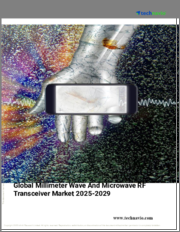
|
시장보고서
상품코드
1755467
CAN 트랜시버 시장 규모, 점유율, 성장 분석, 용도별, 버스 유형별, 데이터 레이트별, 컴포넌트 유형별, 최종사용자별, 지역별 - 산업 예측(2025-2032년)CAN Transceivers Market Size, Share, and Growth Analysis, By Application (Automotive, Industrial Automation), By Bus Type (Standard CAN, CAN FD (Flexible Data-Rate)), By Data Rate, By Component Type, By End User, By Region - Industry Forecast 2025-2032 |
||||||
CAN 트랜시버 세계 시장 규모는 2023년에 31억 달러로 평가되었고, 예측 기간(2025-2032년) CAGR은 8.6%로 2024년 33억 7,000만 달러에서 2032년에는 65억 1,000만 달러로 성장할 전망입니다.
CAN 트랜시버 시장은 다양한 전자 시스템 및 장치 간의 데이터 교환에 필수적인 CAN 프로토콜을 통한 효율적인 통신을 촉진하는 데 중요한 역할을 하고 있습니다. 이 트랜시버는 마이크로컨트롤러의 디지털 신호를 물리적 신호로 변환하는 역할을 하며, 네트워크 내 원활한 통신을 위해 필수적입니다. 주로 자동차 부문에서 사용되는 CAN 트랜시버는 엔진, 변속기, 차체 제어 모듈과 같은 전자 제어 장치(ECU) 간의 상호 작용을 가능하게 합니다. 최근 분석을 통해 이 부문의 성장 역학에 영향을 미치는 주요 시장 성장 촉진요인, 새로운 트렌드, 잠재적 제약 및 기회를 파악할 수 있었습니다. 이러한 요소들을 이해하는 것은 진화하는 CAN 트랜시버의 상황을 탐색하고 자동차 통신 솔루션을 강화하기 위해 진보를 활용하고자 하는 이해관계자들에게 매우 중요합니다.
목차
서론
- 조사 목적
- 조사 범위
- 정의
조사 방법
- 정보 조달
- 2차와 1차 데이터 방법
- 시장 규모 예측
- 시장 전제조건과 제한
주요 요약
- 세계 시장 전망
- 공급과 수요 동향 분석
- 부문별 기회 분석
시장 역학과 전망
- 시장 개요
- 시장 규모
- 시장 역학
- 성장 촉진요인과 기회
- 성장 억제요인과 과제
- Porter의 Five Forces 분석
주요 시장 인사이트
- 중요 성공 요인
- 경쟁 정도
- 주요 투자 기회
- 시장 생태계
- 시장의 매력 지수(2024년)
- PESTEL 분석
- 거시경제 지표
- 밸류체인 분석
- 가격 분석
- 규제 분석
- 이용 사례
CAN 트랜시버 시장 규모 : 용도별&CAGR(2025-2032년)
- 시장 개요
- 자동차
- 산업 자동화
- 가전제품
- 의료기기
- 항공우주 및 방위
CAN 트랜시버 시장 규모 : 버스 유형별&CAGR(2025-2032년)
- 시장 개요
- 표준 CAN
- CAN FD(플렉서블 데이터 레이트)
- CAN XL
CAN 트랜시버 시장 규모 : 데이터 레이트별&CAGR(2025-2032년)
- 시장 개요
- 저속 CAN(최대 125Kbps)
- 고속 CAN(최대 1Mbps)
- 초고속 CAN(1Mbps 이상)
CAN 트랜시버 시장 규모 : 컴포넌트 유형별&CAGR(2025-2032년)
- 시장 개요
- 집적회로(IC)
- 트랜시버 모듈
- CAN 인터페이스를 갖춘 마이크로컨트롤러
- 아이솔레이터
CAN 트랜시버 시장 규모 : 최종사용자별&CAGR(2025-2032년)
- 시장 개요
- OEM
- 애프터마켓 공급업체
- 시스템 통합사업자
- 서비스 제공업체
CAN 트랜시버 시장 규모&CAGR(2025-2032년)
- 북미
- 미국
- 캐나다
- 유럽
- 독일
- 스페인
- 프랑스
- 영국
- 이탈리아
- 기타 유럽
- 아시아태평양
- 중국
- 인도
- 일본
- 한국
- 기타 아시아태평양
- 라틴아메리카
- 브라질
- 기타 라틴아메리카
- 중동 및 아프리카
- GCC 국가
- 남아프리카공화국
- 기타 중동 및 아프리카
경쟁 정보
- 주요 5개사 비교
- 주요 기업의 시장 포지셔닝(2024년)
- 주요 시장 기업이 채택한 전략
- 최근 시장 동향
- 기업의 시장 점유율 분석(2024년)
- 주요 기업 개요
- 기업 상세
- 제품 포트폴리오 분석
- 기업 부문별 점유율 분석
- 매출 전년대비 비교(2022-2024년)
주요 기업 개요
- Texas Instruments(미국)
- Analog Devices, Inc.(미국)
- Microchip Technology(미국)
- Infineon Technologies(독일)
- Renesas Electronics(일본)
- STMicroelectronics(스위스)
- ON Semiconductor(미국)
- Toshiba Electronic Devices & Storage Corporation(일본)
- ROHM Semiconductor(일본)
- Silicon Labs(미국)
- TDK Corporation(일본)
- Murata Manufacturing(일본)
- Melexis(벨기에)
- Elmos Semiconductor SE(독일)
- NVE Corporation(미국)
결론과 제안
LSH 25.07.01Global CAN Transceivers Market size was valued at USD 3.1 billion in 2023 and is poised to grow from USD 3.37 billion in 2024 to USD 6.51 billion by 2032, growing at a CAGR of 8.6% during the forecast period (2025-2032).
The CAN Transceivers market plays a crucial role in facilitating efficient communication via the CAN protocol, which is essential for data interchange among various electronic systems and devices. These transceivers function by converting digital signals from microcontrollers into physical signals, vital for seamless communication within networks. Primarily utilized in the automotive sector, CAN transceivers enable interaction among Electronic Control Units (ECUs) including the engine, transmission, and body control modules. Recent analyses reveal key market drivers, emerging trends, potential constraints, and opportunities that impact growth dynamics in this sector. Understanding these elements is critical for stakeholders aiming to navigate the evolving landscape of CAN transceivers and leverage advancements for enhanced automotive communication solutions.
Top-down and bottom-up approaches were used to estimate and validate the size of the Global CAN Transceivers market and to estimate the size of various other dependent submarkets. The research methodology used to estimate the market size includes the following details: The key players in the market were identified through secondary research, and their market shares in the respective regions were determined through primary and secondary research. This entire procedure includes the study of the annual and financial reports of the top market players and extensive interviews for key insights from industry leaders such as CEOs, VPs, directors, and marketing executives. All percentage shares split, and breakdowns were determined using secondary sources and verified through Primary sources. All possible parameters that affect the markets covered in this research study have been accounted for, viewed in extensive detail, verified through primary research, and analyzed to get the final quantitative and qualitative data.
Global CAN Transceivers Market Segments Analysis
Global CAN Transceivers Market is segmented by Application, Bus Type, Data Rate, Component Type, End User and region. Based on Application, the market is segmented into Automotive, Industrial Automation, Consumer Electronics, Medical Devices and Aerospace and Defense. Based on Bus Type, the market is segmented into Standard CAN, CAN FD (Flexible Data-Rate) and CAN XL. Based on Data Rate, the market is segmented into Low-Speed CAN (up to 125 Kbps), High-Speed CAN (up to 1 Mbps) and Very High-Speed CAN (greater than 1 Mbps). Based on Component Type, the market is segmented into Integrated Circuit (IC), Transceiver Modules, Microcontrollers with CAN Interfaces and Isolators. Based on End User, the market is segmented into Original Equipment Manufacturers (OEMs), Aftermarket Suppliers, System Integrators and Service Providers. Based on region, the market is segmented into North America, Europe, Asia Pacific, Latin America and Middle East & Africa.
Driver of the Global CAN Transceivers Market
The growing adoption of the CAN protocol across multiple sectors, including automotive, industrial automation, medical equipment, and building management, is significantly boosting the need for CAN transceivers. These transceivers are crucial for facilitating effective communication over the CAN protocol, which is essential for the seamless operation of connected devices in these industries. As businesses focus on enhancing efficiency and connectivity in their systems, the demand for reliable CAN transceivers continues to rise, making them integral components in modern technological applications. This upward trend reflects a broader shift towards increased automation and interconnectivity in various fields.
Restraints in the Global CAN Transceivers Market
The Global CAN Transceivers market faces significant challenges due to intense competition among numerous established companies and emerging players. This high level of rivalry often results in pricing pressures that can adversely impact the profit margins of businesses within the industry. As companies strive to maintain or capture market share, they may resort to lowering prices, which ultimately affects their overall profitability. Such market dynamics necessitate innovative strategies and operational efficiencies to sustain growth and ensure financial stability in an increasingly crowded landscape. Ultimately, the ability to navigate these competitive pressures will be crucial for success in the CAN Transceivers market.
Market Trends of the Global CAN Transceivers Market
The Global CAN Transceivers market is experiencing a significant shift towards miniaturization and integration, driven by the increasing demand for compact and lightweight electronic systems in sectors such as automotive and consumer electronics. As manufacturers prioritize space efficiency and performance, there is a rising trend in the development of smaller, high-performance CAN Transceivers that seamlessly integrate into complex electronic architectures. This trend not only enhances the functionality of devices but also supports the advancement of Internet of Things (IoT) applications and autonomous vehicles, paving the way for innovation while meeting stringent space and weight constraints. As a result, the CAN Transceivers market is positioned for robust growth in the coming years.
Table of Contents
Introduction
- Objectives of the Study
- Scope of the Report
- Definitions
Research Methodology
- Information Procurement
- Secondary & Primary Data Methods
- Market Size Estimation
- Market Assumptions & Limitations
Executive Summary
- Global Market Outlook
- Supply & Demand Trend Analysis
- Segmental Opportunity Analysis
Market Dynamics & Outlook
- Market Overview
- Market Size
- Market Dynamics
- Drivers & Opportunities
- Restraints & Challenges
- Porters Analysis
- Competitive rivalry
- Threat of substitute
- Bargaining power of buyers
- Threat of new entrants
- Bargaining power of suppliers
Key Market Insights
- Key Success Factors
- Degree of Competition
- Top Investment Pockets
- Market Ecosystem
- Market Attractiveness Index, 2024
- PESTEL Analysis
- Macro-Economic Indicators
- Value Chain Analysis
- Pricing Analysis
- Regulatory Analysis
- Case Studies
Global CAN Transceivers Market Size by Application & CAGR (2025-2032)
- Market Overview
- Automotive
- Industrial Automation
- Consumer Electronics
- Medical Devices
- Aerospace and Defense
Global CAN Transceivers Market Size by Bus Type & CAGR (2025-2032)
- Market Overview
- Standard CAN
- CAN FD (Flexible Data-Rate)
- CAN XL
Global CAN Transceivers Market Size by Data Rate & CAGR (2025-2032)
- Market Overview
- Low-Speed CAN (up to 125 Kbps)
- High-Speed CAN (up to 1 Mbps)
- Very High-Speed CAN (greater than 1 Mbps)
Global CAN Transceivers Market Size by Component Type & CAGR (2025-2032)
- Market Overview
- Integrated Circuit (IC)
- Transceiver Modules
- Microcontrollers with CAN Interfaces
- Isolators
Global CAN Transceivers Market Size by End User & CAGR (2025-2032)
- Market Overview
- Original Equipment Manufacturers (OEMs)
- Aftermarket Suppliers
- System Integrators
- Service Providers
Global CAN Transceivers Market Size & CAGR (2025-2032)
- North America (Application, Bus Type, Data Rate, Component Type, End User)
- US
- Canada
- Europe (Application, Bus Type, Data Rate, Component Type, End User)
- Germany
- Spain
- France
- UK
- Italy
- Rest of Europe
- Asia Pacific (Application, Bus Type, Data Rate, Component Type, End User)
- China
- India
- Japan
- South Korea
- Rest of Asia-Pacific
- Latin America (Application, Bus Type, Data Rate, Component Type, End User)
- Brazil
- Rest of Latin America
- Middle East & Africa (Application, Bus Type, Data Rate, Component Type, End User)
- GCC Countries
- South Africa
- Rest of Middle East & Africa
Competitive Intelligence
- Top 5 Player Comparison
- Market Positioning of Key Players, 2024
- Strategies Adopted by Key Market Players
- Recent Developments in the Market
- Company Market Share Analysis, 2024
- Company Profiles of All Key Players
- Company Details
- Product Portfolio Analysis
- Company's Segmental Share Analysis
- Revenue Y-O-Y Comparison (2022-2024)
Key Company Profiles
- Texas Instruments (USA)
- Company Overview
- Business Segment Overview
- Financial Updates
- Key Developments
- Analog Devices, Inc. (USA)
- Company Overview
- Business Segment Overview
- Financial Updates
- Key Developments
- Microchip Technology (USA)
- Company Overview
- Business Segment Overview
- Financial Updates
- Key Developments
- Infineon Technologies (Germany)
- Company Overview
- Business Segment Overview
- Financial Updates
- Key Developments
- Renesas Electronics (Japan)
- Company Overview
- Business Segment Overview
- Financial Updates
- Key Developments
- STMicroelectronics (Switzerland)
- Company Overview
- Business Segment Overview
- Financial Updates
- Key Developments
- ON Semiconductor (USA)
- Company Overview
- Business Segment Overview
- Financial Updates
- Key Developments
- Toshiba Electronic Devices & Storage Corporation (Japan)
- Company Overview
- Business Segment Overview
- Financial Updates
- Key Developments
- ROHM Semiconductor (Japan)
- Company Overview
- Business Segment Overview
- Financial Updates
- Key Developments
- Silicon Labs (USA)
- Company Overview
- Business Segment Overview
- Financial Updates
- Key Developments
- TDK Corporation (Japan)
- Company Overview
- Business Segment Overview
- Financial Updates
- Key Developments
- Murata Manufacturing (Japan)
- Company Overview
- Business Segment Overview
- Financial Updates
- Key Developments
- Melexis (Belgium)
- Company Overview
- Business Segment Overview
- Financial Updates
- Key Developments
- Elmos Semiconductor SE (Germany)
- Company Overview
- Business Segment Overview
- Financial Updates
- Key Developments
- NVE Corporation (USA)
- Company Overview
- Business Segment Overview
- Financial Updates
- Key Developments



















